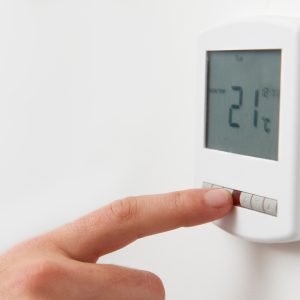
Protect Your Home this Winter
With cold weather well on it’s way, now is the perfect time to ensure your home stays protected from cold temperatures this winter. Taking these steps to winterize your home will keep bigger and more costly problems from coming up in the future. Read on for the 5 tips to winterize your home this cold season, from our Construction Project Manager, Scott Fox.
1. Prevent Your Pipes From Freezing
Frozen pipes aren’t just an inconvenience that blocks water from running into your home, but they can also be costly to repair should they burst. “Temperatures at or below 20 degrees Fahrenheit can cause water in the pipes to freeze,” says Gary McCoy, Store Manager at Lowe’s. “When that happens, the water—now ice—in your pipes expands and exerts pressure on the pipe. Too much pressure can lead to a ruptured pipe.” Pipes that run along exterior walls or have little to no insulation are most susceptible to freezing as are supply pipes in unheated interior areas.

Keep Water Running & Protect Exterior Faucets!
Let cold water drip from indoor faucets located near walls without proper insulation. “A small water drip is all that is needed to keep water moving through the system and prevent frozen pipes.” Joe Cobb, Customer Training Manager at The Home Depot.
Preventing frozen pipes has outdoor components, too, as sprinkler systems, swimming pool lines, and hoses are all susceptible to freezing. “For any outdoor faucets with cutoff valves, be sure they are closed, and faucets are drained,” says Cobb. Additionally, you can cover exterior faucets with insulated covers to help retain warmth from the home’s interior. Keep garden hoses disconnected from exterior faucets to prevent water from freezing inside the hose
2. Clean Your Gutters
Cleaning your gutters is an essential part of preparing for winter. If water gets trapped in your gutters during cold temperatures, it can freeze and force ice back under the edge of your home’s shingles, causing long term damage and making your roof susceptible to leaks. “To prevent clogging, inspect and clean the gutters of leaves and other debris,” says McCoy. “For a shortcut, you could consider purchasing gutter guards. They will help keep out leaves, pine needles, roof sand grit, and other debris from your gutter, and only need to be occasionally brushed off.”


3. Check Your Thermostat
If your thermostat gives out on you during winter, you won’t have a working heat source to keep the inside of your home warm. It’s possible all your thermostat needs are new batteries, so be sure to have some on hand before severe weather hits. If the entire thermostat stops working and you need a replacement, electric heaters are the safest short-term heating solution. “They can be used to effectively heat smaller spaces and should be kept away from any flammable materials,” says McCoy.
4. Make an Emergency Kit
Preparedness is key when it comes to severe winter weather. “The Red Cross encourages every household to have an emergency preparedness kit with essentials for evacuations, loss of power, or if you are stuck in your home for an extended period of time,” says Stephanie Fox of American Red Cross National Headquarters. “These kits should include non-perishable food items, water, extra prescription medication, a first aid kit, copies of important documents, flashlights and lanterns with extra batteries, extra sets of warm clothing, and specific items to accommodate pets, children, the elderly, or any family members who may have a disability.
5. Protect Your Outside Equipment
Just as you want to keep everything inside your home safe, you also want to protect your outdoor items, as well. “You’ll need to bring plants and flowering trees inside before the first cold snap,” says McCoy. “You should also consider storing your outdoor furniture and grills in the basement or garage, as cold temperatures, snow, and ice can cause them damage.” If your house doesn’t have enough storage space for this, consider purchasing covers for your grill and patio furniture.


